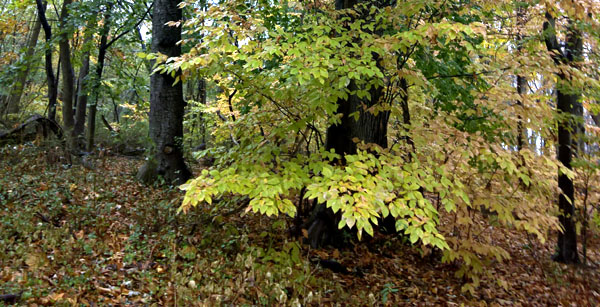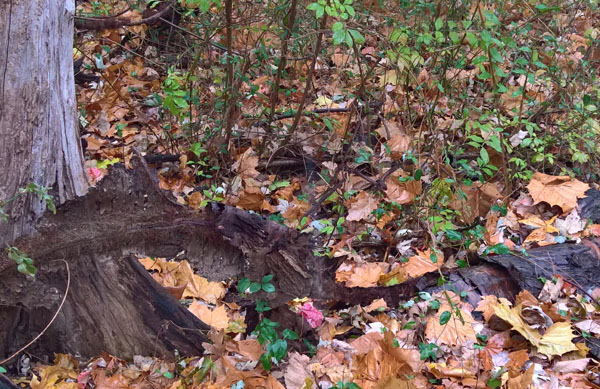A First Walk With the Woods
“Trees are sanctuaries. Whoever knows how to speak to them, whoever knows how to listen to them, can learn the truth. They do not preach learning and precepts, they preach, undeterred by particulars, the ancient law of life.”
– Hermann Hesse, Poet Bäume. Betrachtungen und Gedichte
Please note that this session is described with the full permission of the client and all mention of person, gender and private topics have been removed. I print this with such a sense of gratitude to the courageous and graceful client who knowingly agreed to be my first participant as a soon to be certified Ecotherapist. Also, thank you to those who have written recently asking for more articles written from my first-person perspective, though this article was in process, I’m still glad its released today.
* * *
I hefted the weight of the first aid kit in my hand; sturdy, full of solutions. It felt solid and real, which is what the exercise of constructing it and my survival backpack had brought to my understanding of Ecotherapy; reality.
From the splint to the protein bar, to the Pulse-Ox meter (an addition I had made both for health needs and to integrate some of my biofeedback skills) gathering each item had forced me to think about the “What ifs” of a counseling session outdoors. Band-aids? Check. Client notebook? Check. Tick remover? Check. Rope? Check.
I was prepared for any manner of situation, studied up on the therapeutic invitations that I would use in the field for my first Ecotherapy session. I was nervous and highly excited at the prospect and as yet I hadn’t even left my house.
 I met my client at a local park that we had agreed upon prior because it offered various elements that could prove valuable to the chosen session topic; tall oak, wide glens and a meandering stream. It had been raining off and on all day and we agreed that this wouldn’t get in the way of the session and in some ways even seemed more appropriate. The park was lush and seemed to beckon us deeper into the red-golden shelter of its leaves.
I met my client at a local park that we had agreed upon prior because it offered various elements that could prove valuable to the chosen session topic; tall oak, wide glens and a meandering stream. It had been raining off and on all day and we agreed that this wouldn’t get in the way of the session and in some ways even seemed more appropriate. The park was lush and seemed to beckon us deeper into the red-golden shelter of its leaves.
Before embarking my client chose a spot that, to them, seemed to mark the start of our journey. This demarcation is symbolic while also being a clear neurological signal to ourselves since “we are perpetually in a manic state, seldom fully present in the moment” clinical psychologists and Ecopsychology educators Lane and Sarah Conn wrote in Ecotherapy. They advise to “begin by slowing down and stepping back from your usual way of interacting with the world around you” (2009). The client also checked their pulse rate at the start to get a baseline reading. I should have also checked mine, such was my anticipation as a first time guide. We settled ourselves, the client made their purpose known, honored the forest and the journey in their own way and crossed the threshold. My role was just to help to open their eyes, ears and nose to the welcoming woods, including the patter of the rain on our umbrellas which almost added another layer of sheltering comfort to the container of our session.
We talked about what they liked about fall as a means of both orienting to the environment and helping to set the thematic stage for our conversation. “Fall is a time of drawing in and letting go” they said, “when hidden things are revealed over time; not an ending, just a change.” Their chosen session topic echoed aspects of this insight, though they didn’t realize it at the time. They are not alone in this seasonal kinship, in fact “the idea of the self as existing within a seasonal process reflects back the idea that we are not static in terms of our state of mind or our ability to transcend difficulties,” according to Martin Jordan, clinical psychologist, psychotherapist and international expert on Ecotherapy, “We are always in a process of change and transition from one season to the next. This idea has been used in lifespan psychology to understand the seasons of a person’s life” (2009).
The Wisdom of a Tree
“I only went out for a walk and finally concluded to stay out till sundown, for going out, I found, was really going in.”
– John Muir, Author and Philosopher
The conversation meandered as we did, the client leading in both senses. I noticed that the more we talked the less immersed they were in the environment. The forest itself is co-therapist, and the reason we were there in the first place. As we walked onto a small bridge and they chose to turn their back on the development in the distance in favor of the woods it was an appropriate time to offer space for the co-therapist to take the lead. I invited the client to go one sense at a time, hearing or smelling with eyes closed, to focus on. They chose hearing. We used deep breathing to settle our bodies and focus only on what we heard. As they did the client would label the sounds. The client became quieter and quieter until the sound of the rain, occasional birds and breeze filled their senses. The client checked their pulse when they had been fulfilled by the exercise and noted that the rate had gone up “but I feel really calm.” We filed that away for later discussion as the client was now quite immersed in the experience.
It was the client’s goal to seek out a tree to gain wisdom from on their session topic. I gave space and they walked on, moving through brambles and over a fallen tree until the client found one to which they were drawn. I invited the client to do a sensory exploration of the tree and describe to me or to themselves what they experienced to foster neurological processing of the sensory data and deepen the relationship. The client did so and as they quieted, hands on the tree, I moved off. They stood, eyes closed, with hands on the tree and I bowed out to the co-therapist. When the client’s eyes opened again, wiping a tear away, we discussed the experience. They noted that their hands felt a warmth against the tree bark that was markedly different from the cold air around them and which was surprising. They discussed how the interactions and observations related thematically to their chosen topic in deeper processing, similar to psychodynamic conversation.
We discussed what the client would take back to their life from this experience and they noted multiple ways they could relate this experience to areas they were already developing or desired to focus more on. This included a more seasonal view of themselves. As they touched the bark, seeking a physical memento to take back with them, the client found no loose pieces and was loathe to pull one off. They found a piece that had been shed—harkening back to their first observation of fall being a time of letting go of what is unneeded—and just then the maple dropped a leaf, damp with rain, which fell gracefully near the client. They tucked that in their pocket as well.
As we knew our time with the co-therapist was ending, the client again checked their pulse rate, noting it was lower than on the bridge but still higher than at the start, also still incongruous to the pervading sense of peace that they had. We talked about the transition back to the world outside the park and they appreciated the reminder that they would be going back to a faster pace environment with more demands—one of which was driving a car.
As is the practice in Ecotherapy, we paused for a final moment of reflection and gratitude. The client reviewed all that they had learned, including the meter readings, which may indicate that the natural environment is both emotionally and mentally calming to them while also being physically invigorating for them—and its supported by evidence from a multi-university Japanese governmental study. The study found that “liveliness scores increased significantly” for those who participated in guided forest walks, while reducing stress so dramatically that “the higher the stress level” you bring to the forest, “the greater the effect” (Morita, 2007). We briefly considered how they could incorporate those benefits on a regular basis as part of a self-care practice.
In farewell the client chose to do “tree pose for the tree” and they noted the flexibility, strength and grace that it took to hold that pose, which echoed what they had found in the tree and within themselves.
__________________________________________________
Ecotherapy: Healing with Nature in Mind, Buzzell, L. & Chalquist, C. (2009). San Francisco: Sierra Club Books. ISBN 978-1-57805-161-8
Jordan, M. (2009) Back to nature. Therapy Today. Retrieved from: http://www.ecotherapy.org.uk/files/ecotherapy/home/Therapy_today_article_on_ecotherapy.pdf
Morita, E. (et al) (2007) Psychological effects of forest environments on healthy adults. Journal of the Royal Institute of Public Health. Retrieved from: http://www.natureandforesttherapy.org/uploads/8/1/4/4/8144400/_psychological_effects_of_forest_environments_on_healthy_adults….pdf


